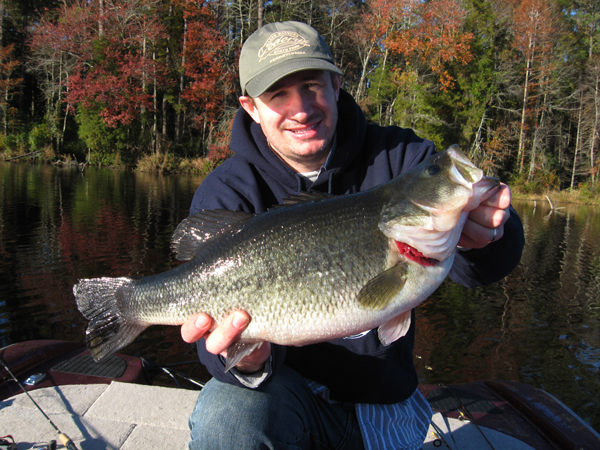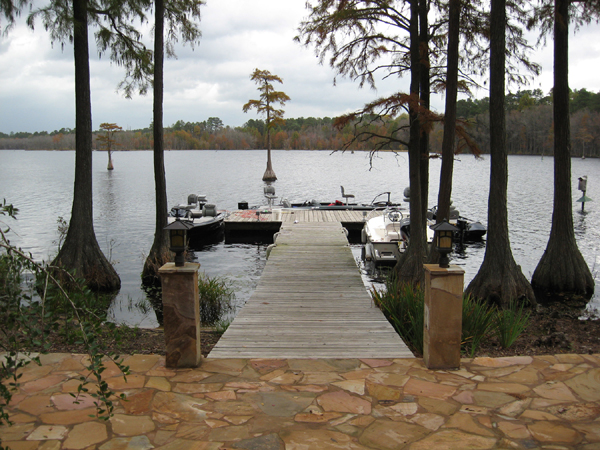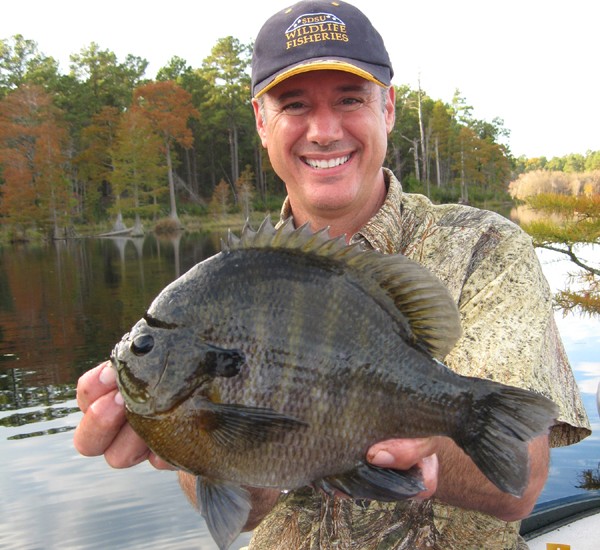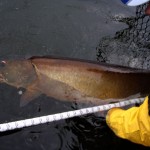One of the most intriguing bodies of water in North America is Richmond Mill Lake in Southern North Carolina. This is a small 120-acre intensely managed body of water that currently sports some of the best largemouth bass fishing in the nation and the bluegill fishing is unequaled. The lake was impounded back in 1835, is rich in pre-Civil War history, and has a long and storied past of fishing successes. Owned and operated by Jim Morgan of Laurel Hill, North Carolina, Morgan has gone to extreme measures to make this one of the top fisheries in the nation.
I had the great pleasure to experience the fishing at Richmond Mill in October or 2009 and in May of 2010. I was joined both times by top fisheries biologist Bob Lusk, of Pond Boss fame, and world-class angler Bruce Condello as we fished almost exclusively for the lake’s population of huge bluegills. Rumors had it that this was a sensational fishery for monster bluegills due to the supplemental feeding offered by automated feeders that were intended to bolster the size of the lake’s bass. However the byproduct turned out to be 2-pound plus bluegills. What a byproduct!

Back in 2001 Richmond Mill Lake was drained due to needed work on the dam and spillway. While the water was down, Morgan decided to completely renovate the lake, clear out the stumps, install automated feeder systems, restock with largemouth bass that were the cross between a northern largemouth and a florida bass and coppernose bluegills, then refill the lake in an attempt to create a world class fishery. It wasn’t easy and industry heavies like Bob Lusk, Ray Scott of BASS fame combined to form one of the Legacy Lakes that are found throughout the south and managed specifically for outstanding bass fishing. Again, the byproduct of huge pan fish can also be a draw.

The water at Richmond Mill is not unlike that of the Delaware or southern Maryland. The water is shallow, averaging 4 feet, and has a dark tannic color to it and the shoreline is inundated with stumps, brushpiles, and numerous cypress trees. One might think they are actually in Delaware rather than the coastal plain area of North Carolina. The lake was refilled in 2005 so all adult fish in this lake are currently no older than six years. Some bass were stocked in the 1 to 2 pound range and coppernose bluegill in the 4 to 5 inch range. The current size structure of the bass is that 5 to 8 pound fish are frequent catches and the legitimate chance of a 2-pound bluegill is a daily thing.

When I visited Richmond Mill in May of 2010 we found huge spawning bluegills literally within inches of the shoreline. Tight, accurate casts were required to get baits or lures in where the fish were. We couldn’t actually see spawning beds for the bluegills due to the black water of the lake, but we knew they were there as bulging females and thick robust males would attack tiny topwaters and inline spinners if we could get them in front of them. Some of the surface action with these bluegills was unbelievable. We would use small Rapalas and Strike King Bitsy Minnows and get explosive strikes from fish that went ballistic. We used 4-pound test to make these accurate casts in and around brush, overhangs and stick-ups and stumps. The power of a 2-pound bluegill is hard to explain. More than once we would hook big fish that would just bury into the tangles and we would inevitably lose the fish and the lure, If we would get them out away from the sticks, chances were good for success. But then again that was part of the challenge. Heavier line would reduce our casting distance and we could not get it back where we wanted.
Along the way, we would pick up 3 to 5 pound largemouths,”non-target” specie for Condello and I. Sure, most anglers would jump at the chance for largemouths at that size, especially in high number. Throw in a legitimate shot at an 8-pound fish and most bass anglers could care less about the bluegills, but we were just the opposite. Other species that showed up were chain pickerel to 24 inches, crappie to 15, redbreast sunfish over a pound, and a few other surprises.

It is clear to me that Jim Morgan, Bob Lusk, and all others involved in this lake’s success story have done their homework, put in their time and effort and have created a world class fishery. The small lodge on the lake is also first class and offers of gourmet meals and guided fishing and hunting packages are available. Known as the King Fisher Society, the facility at Richmond Mill Lake offers you a chance to literally step back in time as the lake was impounded in 1835 and is richly steeped in Civil War history. Jim Morgan has published a book recently entitled, “Richmond Mill Lake The History”. It is a short, informative and entertaining overview of the lake’s history, dynamics, and changing of hands over several generations dating back to that time. Richmond Mill always had some big fish in it but modern fisheries management has overcome complications such as a high flow rate and acidic conditions to create exceptional angling.

So? How did we do fishing wise? From the standpoint of bluegill fishing this may be the best fishery in the nation. Fish averaging between 10 and 11 inches long are quite common and your chance of catching a 12-inch, 2 pound giant are very good. Our biggest back in May was a 2-7 caught by Condello on a top water. Several other 2 pound plus fish were caught by other visiting anglers. Me, well, I didn’t’ get a 2 pounder. My top four fish were between 1-13 and 1-15. Was I disappointed? No! The trip I took back in October rewarded me with four bluegills from 2 pounds to 2 pounds 2 ounces. Just about everybody caught largemouths over 5 and several members in our party got big chain pickerel. This was all during stifling hot, mid-ninety degree weather.

With the automated feeder system, hi-protein Purina Aqua-Max fish food supplements the current natural diet of freshwater shrimp, small minnows, golden shiners, various larvae and other forage species.
In November of 2010 my son Matt and I spent a few days at Richmond Mill for the father/son fishing trip of a lifetime. Despite chilly, low-thirty degree mornings and water temps in the upper fifties, we caught bass, pickerel, trophy gills and slab crappie on a variety of my River Critter Hairjigs and on #3 and #5 Rapalas and Mepps spinners. The fishing was literally off the charts. In two days of fishing we caught 11 bass from 5 to 6 pounds and another thirty over four. Throw in many 11 to 12 inch bluegills, two-pound crappies, pickerel to 25 inches and, well, you get the picture.


The King Fisher Society also offers outstanding quail hunting on their 2000 acre preserve, great accommodations at the lodge and gourmet dining and live jazz music. They offer a truly remarkable freshwater fishing experience. Contact them at 910-462-2324, or click on kingfishersociety.com. Great fishing, great hospitality at a fabulous setting.






